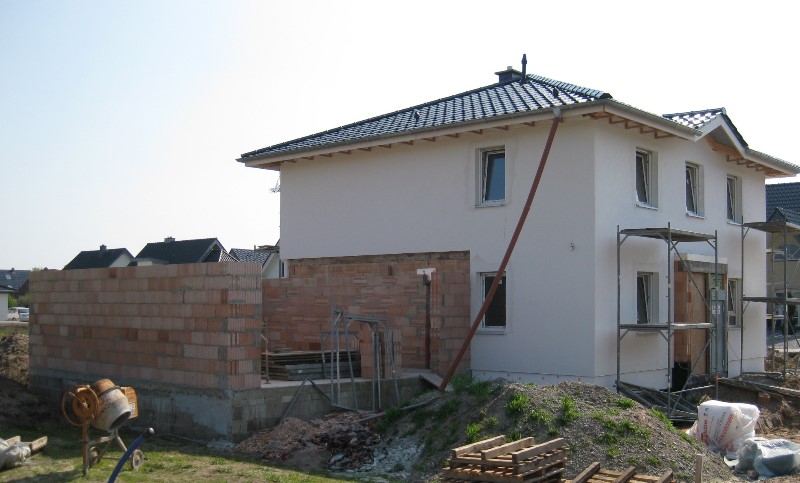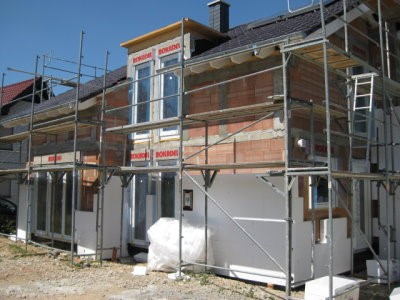Save money on turnkey solid house - Calculate Now
Turnkey or ready for occupancy - Which is cheaper?
Whether a builder is better off with a turnkey or ready-to-occupy solid house in terms of cost always depends on the individual case. If you do not have any expertise in interior finishing and do not have any experienced helpers in the vicinity, you are certainly better off with a ready-to-move-in solid house. If a builder commissions several small companies with the interior finishing of his house, he usually pays more than a developer, who can negotiate good discounts with the specialist companies due to the volume of his orders.

The situation is different if the builder himself is in a position to lend a hand with the interior work. Then the costs incurred for the commissioning of specialist companies fall. This is also possible due to the fact that auxiliary work can be carried out for the specialists. Such arrangements are more likely to be arranged with small specialist firms than with the large companies that are usually employed by a developer to do the interior work. The following services can be considered as support for specialist firms:
- Preparing cable ducts
- Helping with cleaning and painting
- logistical work such as carrying materials
- supplying tools
- cleaning work
- preparation of floors and walls (filling, grinding)
What are the advantages of in-house services provided in this way?
The own achievements furnished by the owner with a massif house handed over ready for occupancy lower the building costs on the one hand directly, by omitting or at least drastically lowering the fees of the pure work achievement which can be furnished by the specialized companies. The material costs always result, all the same whether the owner takes over work with the interior fittings himself or gives into the hands of specialists. However, the builder can influence the cost of materials when carrying out interior work as an internal service, for example, by taking advantage of seasonal discounts or by stocking up on the necessary materials at bankruptcy sales.
How do own contributions in the turnkey solid house affect the financing?
One consequence of extensive personal contributions by the builder is that the total construction sum required is reduced. This reduces the need for borrowed capital. Since own contributions are always added to the equity capital, the builder achieves a better ratio of equity capital to borrowed capital with the banks. And this ratio in turn has a decisive effect on the interest rates charged by the banks on the construction financing. The higher the equity ratio, the lower the interest rates. The services rendered as auxiliary work for the specialist companies, for example, are always taken into account for the equity capital at the hourly rates for construction assistants that are customary in the location and industry.
Owner remains flexible with the ready for occupancy massif house
If a massif house is given ready for occupancy with a building contractor in order, the owner must commit itself at an early stage very concretely to its desires with the interior fittings. One reason for this is that a fixed price is usually agreed for the building project. If a solid house is handed over ready for occupancy against it, the owner can still change its desires up to the execution of the individual work. This starts with the choice of interior doors and extends to the number and distribution of sockets in a room. It would also be possible to change the planned use of the rooms, with the exception of the kitchens and sanitary areas, until shortly before completion.
What savings can be achieved with a turnkey solid house?
How high the concrete savings turn out with the ready for occupancy massif house in relation to the massif house, depends on numerous individual factors:
- What scope of services can be provided by the builder himself?
- What services can friends and family provide?
- How wisely does the builder make his material purchases?
- How does the capital ratio change?
- What interest rate discount does the builder get from the banks?
- What additional costs are incurred due to the owner's own contributions?
However, when deciding between a ready-for-occupancy and a turnkey solid house, it should also be borne in mind that the construction period is generally extended due to a high level of work carried out by the owner during the interior construction. Here should be considered with the computation of the possible savings therefore also that possibly for a dwelling used up to the move into the own house longer rent must be paid. Among the additional costs fall among other things additional insurance for the building aids and times, in which the owner can be released for the adherence to its dates for example unpaid from the work. Travel to carry out the work yourself should also be included in the additional costs.
Which is better now? - The solid house ready for occupancy or ready for occupancy?
Whether and to which extent the own contributions with a ready for occupancy massif house count themselves, is to be judged thus always only for the respective individual case. A fundamental and for everyone valid evaluation of the lucrativeness of the delivery of a massif house in ready for occupancy condition is therefore impossible. The decision between the ready for occupancy and turnkey solid house should be made only on the basis of a projection on the total accruing costs for the entire project including the rents and the costs of construction financing.
How can I save money on the construction drawing?
Do not immediately take an architect, who plans your dream house completely for you and then also bills this directly. It is cheaper to focus on established larger construction companies from the region and first get a few offers there with standard houses (already built by the construction company).
The floor plans and room layouts change your building consultant usually free of charge. In addition, you can already tell there by the motivation of the building consultant whether they have chosen the right construction company (How to find the right construction company!).
With our online calculator, you can determine how much money can be saved by doing your own work on your building project. We calculate carefully and assume an hourly wage of 20.00 €, which you save per hour.
Please note that the provision of own work is associated with certain risks and that you should take out appropriate insurance even for unpaid construction workers.
Topics: building & Living & Real Estate



